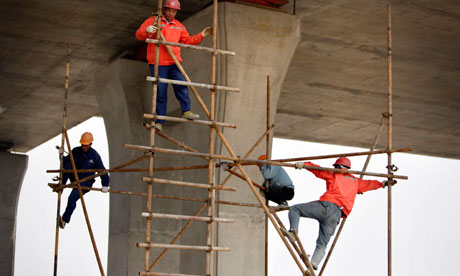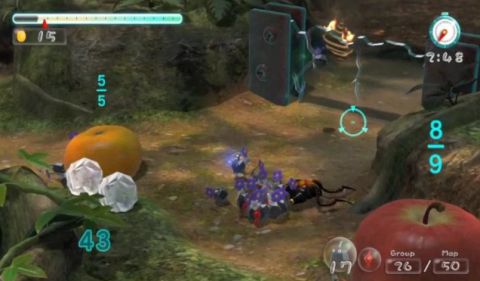Here is an interesting UI issue I’ve encountered developing a prototype: what is a good and easy way to make AI characters perform things together. I’ve crowd-sourced this question on Twitter to look for examples in other games and realized that the question requires some explanation. So let me clarify:
There are numerous games where you control not a single character but a whole group of characters: Lemmings, XCOM, Starcraft, Pikmin, Final Fantasy, etc. What I noticed it that most of the time, the kind of orders you can give to your team members are given to one single team member at a time. The interfaces are great at telling guy A to do X and then guy B to do Y. What I’m looking for are interfaces for making guy A and guy B do X together. Here are some examples and how they do and do not qualify:
-
XCOM – Am obvious example of a game that lets you control a team but doesn’t have any orders that are done together. You just have guys just doing their own things simultaneously. The closest the game gets at cooperation is when one soldier heals another. But even in those cases – the person, who is being healed actually doesn’t have to do anything to cooperate. You can potentially heal a teammate WHILE they are running or shooting at somebody.
-
Pikmin – Pikmin does have activities that require multiple units to cooperate. Most notably, you need to send out a certain number of Pikmin to carry around heavy objects together. Technically, you still give orders to individual Pikmin. It’s just that they do nothing until a certain minimum number of Pikmin have been assigned to a task. The reason why the example is still not useful in my case is because the roles within a task and the Pikmin themselves are interchangeable. When carrying around large objects for every Pikmin within that sub-group does the same thing. Also, you can’t discern or select individual Pikmin – not very well at least. So you would have a hard time to use that interface to staff a rowing team where you need pick the strongest of your guys to do the rowing and the lightest of your guys to be the coxswain.
-
Starcraft – Starcraft let you identify and select individual units. In most cases the orders you give don’t require cooperation, though. There are a few exceptions. Some units can build and repair buildings together. Again, as in Pikmin, Starcraft doesn’t actually discern individual roles in a task either. So when multiple units repair something, they are all doing the same generic repairing action. Units don’t depend on each other or interact with each other when doing a task.
Examples of Activities
To clarify the problem, here are some examples for cooperative tasks that might be difficult to model in the above games:
-
Climbing a Wall – Climbing a wall usually requires the cooperation of two people. One person does the climbing while another person belays them. Who is doing the climbing and who belays them is very important and should be a thing that the player has control over. More importantly, throughout a mountaineering expedition, who climbs and who belays changes constantly. So you need a flexible interface for being able to decide quickly. This is actually the thing I was trying to model when I stumbled over the problem. I already previously had other activities where I didn’t necessarily NEED cooperation but wished I had an easy UI solution to allow for it.

You know, for all the climbing that you do in games, there is an astonishing lack of belaying.
-
A Road Trip – Usually, on a long road trip, there is one person driving, one person taking care of navigation and the rest (if there is any) is resting in the back seats. As with climbing, the roles here change constantly throughout the trip. As with climbing, who does what can have important consequences for group dynamics and how the trip plays out.

Which seat can I taaaaaaake?
-
Surgery – During a Surgery there are multiple roles to fulfill. There is a Senior Surgeon, Resident Surgeons, an Anesthesiologists, a Scrub Nurse, Circulating Nurses, Students etc. On especially long and complicated operations these can change throughout an individual operation. But more often, the roles just change from surgery to surgery. A Student on one major operation may end up being the Resident Surgeon on a minor operation. Who does what is essential and often lies at the core of the many medical TV dramas.

If I learned anything from TV it’s that one of the most important factors for the outcome of a surgery is not so much competence but who sleeps with whom.
-
A Construction Site – Construction sites have multiple people fulfilling multiple roles. Machines need to be operated. Things need to be carried, dug out, filled in, painted, erected, demolished, etc. Because those activities are usually heavy duty, a lot of them are most efficiently and safely performed in groups – like carrying heavy things or filling a sack with sand. Also, the roles constantly change. You don’t have just that one guy, who always carries things. He might be unloading a truck first but then move on to erect a scaffolding. Evolving priorities and individual skills are important and have to be considered when deleting tasks.

Whatever those guys are doing, it doesn’t look like a one-man-job.
-
Hanging a Picture on a Wall – There are multiple examples for relatively simple, everyday activities that require at least two people to cooperate. Hanging a picture on a wall requires one person to hold the picture while another checks if it is level and draws in marks to where to hammer in the nails. Or you’ll have one person carrying a heavy item while another holds open the doors for them. Setting up tents or folding blankets – all of these require people to work together and often end up being relationship-forming events in film or literature. Consider the cliche of the how young couple renovating a room and splashing each other with paint during a romantic good times montage.

“Teeheehee! We are so in love with each other! Look at us making a huge mess.”
-
Jobs – Some games seem to solve interaction by defining jobs for individual team members. World of Tanks, for example, lets you crew a vehicle with multiple roles: Commander, Gunner, Driver, Radio Operator and Loader. It displays a list of slots that you can fit crew members into. This is generally a useful design pattern that can be applied to a lot of cases. However, it comes with a set of expectations. It already assumes that you always want to drive a tank. World of Tanks is not a game where driving a tank is one of multiple activities you can do. It also assumes that in most cases the crew for a tank tends to stay the same for a long time – you will change crews perhaps every half an hour or so at most. So the process is awkward – you select a crew slot, you dismiss a crew member, confirm a dialogue box, select the empty crew slot, select “Recruit”, chose a new person from the barracks. There are multiple clicks and dialogue boxes necessary to make even the simplest changes. To change crew members every minute, you would need something more streamlined.

Defining a team in World of Tanks. Comprehensible but inflexible and somewhat cumbersome.
-
Waiting Mode – I’ve seem some games that allow two people to cooperate using a system designed to control individuals. They do so by creating intermediate commands. You put one team member into a sort of “waiting mode”. Then you command another team member to walk to and “team up” with them. Pikmin is an obvious example. Your Pikmin gather around an object and wait there until enough Pikmin have gathered to carry it. I think I’ve seen a similar pattern in a Tactical JRPG, but I can’t recall which one (can anyone help me out here?). This works quite well to infuse cooperative elements into an otherwise individual-based UI. Unlike the Job-pattern it allows players to formulate tasks and jobs ad-hoc rather than the system always assuming you do one thing over and over again. The reason why I’m wary with using this pattern is that because the it’s essentially a crutch to have cooperative elements in a UI not designed with them in mind. So involves this awkward 2-step process. It necessarily creates a situation where team members stand around doing nothing while you navigate another person in place to join them. It can be also difficult to visualize this and explain to the player what they need to do in order to complete the process.

Pikmin team up to carry things. Quite flexible but communicating the requirements to the player can be difficult.
-
Stations – Another design pattern that I’ve sometimes seen is to define jobs and tie them to physical places. FTL is an excellent, recent example for this. You see the schematic view of a spaceship. Each room of the ship corresponds to a job. Whoever sits in the cockpit becomes the pilot. Whoever sits in the engineering room becomes the engineer. The game often revolves about constantly delegating crew members to different tasks as the situation evolves and priorities change. This is certainly a more flexible and streamlined pattern than the Job-pattern in World of Tanks. However, it also comes with a set of expectations. Because it is related to the Job-pattern, it expects certain jobs to be always present. You always fly a ship in FTL. It also expects a 1:1 correspondence with places and activities. For example: How would you model an away mission where you can either talk to an alien, scan them with a Tricorder or shoot them?

Two guys fend off a boarding party in the weapons room while the pilot flies the ship and an engineer keeps the shields up. FTL does feature some flexible cooperation but activities are tied to the layout of the ship.
All of these are very straight-forward, common examples of cooperation which are surprisingly under-represented in games. Interestingly, they often end up being catalysts for social interaction. So modelling them in a game should be an attractive thing to try. It is surprising that we apparently don’t have that many examples of games trying this. Instead games either show them from an individual’s perspective (you snipe while the AI does the spotting for you) or they limit themselves to model actions that don’t require two people to directly interact. IThis simple UI issue might be actually related to why games tend to have a rather autistic view on social modeling.
Design Patterns
However, people were so nice to point out some titles to me. With the examples I already had, here are some design patterns I noticed that frequently come up when games at least try to model some form of cooperative interaction. There is no ideal solution so far. But each of the patterns has it’s own strengths and weaknesses:
MOAR EXAMPLES PLZ!
I have an idea how I might be able to solve this issue which I need to try out first. But in the meantime I’m still looking for examples. So please, if you know any game that have you control a team of people that performs tasks together, let me know. Additional examples or variations in the three above patterns are certainly welcome as well!






Rymdkapsel (http://rymdkapsel.com/) uses a jobs-like system, but with a new (to me) UI for assigning workers. There’s an idle slot, and one slot for each job. If there are idle workers, drag from idle to a job to move a worker to that job (and the worker will move to the nearest room for that job and begin doing it). Drag from one job to another to reassign a worker to a different job. You can see it in action in this video: (http://www.youtube.com/watch?v=X9ZiAODbEMc&t=1m29s&)
You being a fan of NHL and not listing it? Altough you directly control only one player a time, actions of the others do matter.
In many simulation games you don’t give order to people directly, but rather create a task. When you decree a building to be erected in Settlers, diggers move in to level the spot, then carriers bring the materials and finally builders come to perform the construction.
Battlefield games feature war machines operated by a number of people. Most prominent are choppers whose pilot has no control over weapons, two players man the turrets and the rest are just passengers.
Most MMOs have so-called ‘holy trinity’ of rigid tank/healer/damager roles.
Disgaea allows one character to lift another and than trow it away at a distance. Being quite a crazy game it allows to stack lifted characters in a pyramid, allowing a chain of throws over greater distance. Also, when certain characters are adjacent to each other they and one of them attacks an enemy, the other also perform an attack of opportunity. This allows smart positioning to greatly increase number of attacks made.
Whilst grouping units in Starcraft just allows to give each individual the same order, groups in Age of Empires and some other RTS shows more coherence. All move together, shieldbearers on the front archers on the back and there is a number of formations to be selected.
I never played WoT, but isn’t the team just a sum of bonus attributes, like pieces of armour in an RPG?
When I initially commented I clicked the “Notify me when new comments are added”
checkbox and now each time a comment is added I get
four e-mails with the same comment. Is there any way you can remove me from that service?
Cheers!